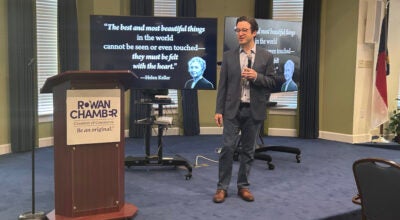Published 12:00 am Sunday, June 30, 2013
SALISBURY — When it comes to Klumac Road, there’s no wrong side of the tracks.
Both sides seem equally bad for businesses these days, now that the state has closed the Klumac railroad crossing.
Klumac was a popular cut-through in the heart of the city that connected South Main Street and South Jake Alexander Boulevard. More than a dozen businesses still call it home, and two major commercial nodes stand at each end.
Between 4,000 and 5,000 vehicles traveled Klumac every day until the N.C. Department of Transportation closed the railroad crossing May 13 as part of a three-year project that will realign Klumac, running it under the tracks about a block from the existing road and connecting it with N.C. 150 near Checkered Flag Barbecue.
Old Klumac now dead ends on either side of the crossing and will not reopen.
On the east side of the tracks, some business owners with a Klumac address say they are angry and confused because DOT erected detour barricades at Jake Alexander Boulevard, making it appear to motorists and potential customers that Klumac is shut down, even though the road remains open for nearly another mile.
“At Klumac and Jake, all you see are huge detour signs. We don’t understand the reason,” said Rhonda Perry, who owns Mike’s Transmission at 715 Klumac Road with her husband. “They are bragging about they’re going to add 26 jobs with the construction, but they’re going to hurt even more than that with the detours.”
During the two weeks following the closure, business at Mike’s Transmission slowed to a trickle, Perry said, and customers still call every day wondering if the shop is open and how to get there.
On the west side of the tracks, business owners on South Main Street say the Klumac closure has cut their walk-in traffic and caused headaches for delivery drivers and customers.
Brandon Kepley, co-owner of NAPA Auto Parts at 1413 S. Main St., said walk-in retail sales are down 13 percent from a year ago. His four delivery drivers, who make about 150 trips a day and work a stone’s throw from the railroad tracks, now have to drive several miles out of their way to cross those tracks.
In the keenly competitive auto parts industry, quick delivery to wholesale customers is crucial, Kepley said, and the Klumac closure has added about eight minutes to each trip.
“Every minute counts,” he said.
Darin Waller, DOT’s resident engineer in Salisbury in charge of the Klumac project, said he knows businesses are hurting.
“I feel for these businesses because I understand they have lost a lot of traffic in front of their businesses,” Waller said.
Business owners want the detour signs moved from Jake Alexander Boulevard to Martin Luther King Jr. Avenue, where motorists could then turn left and take the remainder of the Klumac detour, which reroutes traffic to Highway 29.
Waller said DOT engineers in Raleigh will not change the detour they designed to keep traffic moving on Jake and avoid additional turns. Waller said he understands the frustration of business owners, but moving the detour signs will not bring back the heavy volume of traffic.
About 90 percent of motorists are now going around Klumac, and the road’s status as a cut-through is gone, Waller said. The detour barricades at Jake were specifically positioned to not block traffic, and vehicles can pass through in either direction to travel on Klumac if drivers wish, he said.
To help, the city recently posted a metal sign on an easel announcing “local businesses open,” but merchants said the placard is dwarfed by the detour barricades, poorly located and easy to miss.
“You’d have to be a microscopic reader to see that,” said Randy Elium, the manager of James River Equipment at 805 Klumac Road.
He said he only noticed the sign when he was stuck in traffic and had time to read it.
Waller said unfortunately, complaints like these are common when DOT closes a major artery to make improvements. The state is using federal stimulus dollars to fund most of the $11.7 million Klumac project, which is part of a broader initiative to eliminate at-grade rail crossings and avoid potential train-vehicle collisions.
More than 40 trains cross Klumac every day.
The new Klumac Road, which is scheduled to open in October 2016, will make it safer for drivers, support economic development and allow trains to go faster, eventually up to 90 mph, state officials said.
Meanwhile, businesses on old Klumac are coming to terms with a new reality. Elium called the loss of revenue and increased cost of doing business “collateral damage” from the DOT project.
“This is our lifeline,” he said.
Waller pledged to ask his boss in Raleigh, division construction engineer Keith Raulston, for permission to change the signs on barricades at Jake. Perhaps DOT can place a larger sign that reads “local businesses open” above the barricades, or add a sign that says, “Road closed 3/4 mile ahead,” Waller said.
Typically, DOT only announces “road closed ahead” when the distance is greater than two miles. But Waller said he will ask for an exception.
If the changes are approved, Waller said the new signs could be in place within two weeks.
But he said he doubts they will make much difference.
“I don’t know of anything, honestly, in my opinion that is going to help,” Waller said. “Once you take 4,000 cars off that street, you don’t have the stop-in traffic anymore. Any amount of signs are not going to bring those cars back to Klumac.”
The state should have left the Klumac crossing open for another year or two while constructing the underpass and bridge a block away, business owners said.
“That would have made sense,” Kepley said.
Closing the crossing was the first step in a complicated, linear project with multiple phases during the next three years, Waller said. Crews had to close the crossing to move utilities and cut in ditches, and DOT waited as long as possible to close it, he said.
The next step is building a 3,000-foot-long temporary railroad track for trains to use while crews build the new bridge near the former Driveshaft building and Duke Energy substation.
But construction of the temporary track on Old South Main Street has been delayed. The contractor, Blythe Construction Inc. of Charlotte, has pulled crews off the Klumac project for another job that must be completed while school is out, Waller said.
“It was bad timing,” Waller said.
He said he expects crews to return by the end of July, and the delay will not change the project’s final deadline of October 2016.
Many have questioned the length of the project. Why will it take so long to realign .6 miles of Klumac Road and build a bridge for trains?
“It’s just the nature of the work,” Waller said. “It’s very complex.”
New Klumac Road will run about 30 feet below the elevation of the current railroad tracks, he said. Building a temporary track, rerouting trains, constructing a railroad bridge and then rerouting trains again takes time, he said.
Dealing with the railroad is more time-consuming than a project that involves only cars and trucks, Waller said. Trains must continue to run, he said, and working next to railroad tracks slows down construction.
“They just can’t shut down the track,” Waller said.
Once trains are running on the new bridge, crews will remove the temporary track from Old South Main Street, which will reopen to vehicles but dead end at the Duke Energy substation, Waller said. Motorists still will be able to drive behind Wicked Scissors and other businesses that back up to Old South Main, he said.
Business owners said they received no communication from DOT about the Klumac closure.
“I had heard rumors, but I found out about it the day that it happened,” said Tracey Kluttz, who owns Wicked Scissors. “People are so confused.”
Waller said DOT did not have direct contact with most businesses because the state did not buy right-of-way from any property owners other than the Driveshaft Shop. The state issued several press releases before the closure.
State and local officials also held several public hearings and meetings years ago when DOT was choosing a new alignment for Klumac Road. Those sessions succeeded in saving Johnson Concrete, which has operated a concrete plant on Klumac Road since 1946 and will remain open.
The Driveshaft Shop is the only business that has moved due to the construction. Driveshaft, which manufactures precision parts for race cars, had to abandon its building at 1531 S. Main St. because a temporary train track will run 20 feet behind the building for years, causing excessive vibration, owner Frank Rehak said.
The state used eminent domain to take part of the shop’s parking lot and front lawn, Rehak said. The business also lost the use of its main loading dock because the new Klumac Road will run right in front of the facility, some 20 feet below the elevation of the shop, Rehak said.
Although the state gave Driveshaft about $175,000 for the seized property and paid to move the business to a new location at 4530 Southmark Drive, Rehak said he’s left with a building worth $450,000 that he can’t use or sell.
He had to take out a mortgage to buy the company’s new $1.1 million building, Rehak said.
Rehak said the state offered to pay for an addition to the front of the old shop, but he declined because there was no guarantee his machinery would be far enough away from the vibration of 40 trains a day to work properly.
Now, DOT is suing Driveshaft, Rehak said, and he has hired a Concord attorney to defend the company.
Businesses blocks away from Klumac Road have felt the impact of the closure. Without the cut-through, customers on the east side of the tracks often don’t have time to frequent restaurants on the west side, said Rick Foster, owner of Rick’s Barbeque and Grill at 1617 S. Main St.
“I hear people all the time saying, ‘That’s the reason you don’t see us at lunch anymore,’ ” Foster said.
The restaurant’s lunch sales have fallen because people have a limited time to grab a bite and get back to work, he said. The detour can add precious minutes to their trip, depending on their location, Foster said.
“A few minutes can make the difference,” he said.
Checkered Flag Barbecue owner Kim Alexander said sales are down 10 percent since the road closure. Luckily, Alexander said, construction workers from the Klumac project have been eating at her restaurant at 1530 S. Main St.
“If it wasn’t for the workers coming here, I don’t know what we would have done,” she said.
Alexander said she can see the value in the new underpass and railroad bridge. The road will be safer and could spur more development, she said.
Alexander said she hopes to survive for the next three years without sacrificing the quality or quantity of her food and without passing costs on to her customers. If she can do that, Checkered Flag eventually will sit at the intersection of South Main and the new Klumac Road.
“All I want to do is make it through the next couple years,” Alexander said. “Then I will be at a prime location.”
Contact reporter Emily Ford at 704-797-4264.




